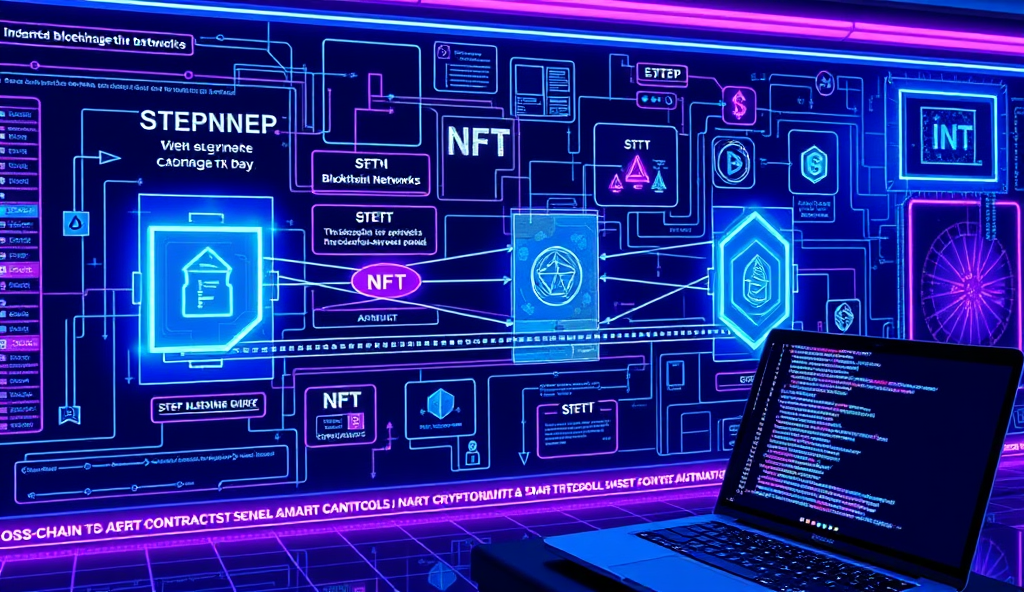Introduction to Cross-Chain NFTs and Their Importance for Collectors
Cross-chain NFTs represent the next evolution of digital collectibles by enabling assets to move seamlessly between different blockchain networks. This interoperability solves critical limitations like platform lock-in, with over 60% of collectors expressing frustration with single-chain NFT restrictions in a 2023 DappRadar survey.
Projects like CryptoPunks expanding to multiple chains demonstrate how cross-chain functionality increases liquidity and accessibility for global audiences.
For collectors, cross-chain NFTs offer unprecedented flexibility in managing and trading digital assets across ecosystems. A single NFT could exist simultaneously on Ethereum for prestige and Polygon for low-cost transactions, creating new opportunities for strategic portfolio management.
This multi-chain approach aligns with the growing trend of collectors diversifying across networks, with cross-chain NFT trading volume growing 320% year-over-year according to Nansen data.
Understanding these cross-chain capabilities becomes essential as the NFT space matures beyond single-network limitations. The following section will explore the technical foundations that make this interoperability possible, including blockchain bridges and universal NFT standards that power seamless asset transfers.
These innovations are reshaping how collectors interact with digital assets across the decentralized landscape.
Key Statistics

Understanding the Basics of NFTs and Blockchain Interoperability
Cross-chain NFTs represent the next evolution of digital collectibles by enabling assets to move seamlessly between different blockchain networks.
At their core, NFTs are unique digital tokens representing ownership of assets, but their true potential emerges when combined with blockchain interoperability. Cross-chain functionality allows these tokens to move between networks like Ethereum, Solana, and Polygon while maintaining their scarcity and provenance, addressing the fragmentation issues highlighted in the previous section’s DappRadar survey findings.
Interoperability relies on standardized protocols like ERC-721 and ERC-1155, which provide the foundation for cross-chain NFT transfers through bridge solutions. Projects like Bored Ape Yacht Club’s expansion to other chains demonstrate how these technical standards enable collectors to leverage different blockchain advantages while keeping asset integrity intact.
As we’ve seen with the 320% trading volume growth, this technical foundation creates new possibilities for cross-chain NFT projects. The next section will explore why WordPress has emerged as a surprisingly effective platform for building these multi-chain digital assets, combining accessibility with powerful blockchain integration tools.
Why WordPress is a Viable Platform for Cross-Chain NFT Projects
WordPress powers 43% of all websites globally offering unmatched accessibility for creators looking to build cross-chain NFT projects without deep technical expertise.
WordPress powers 43% of all websites globally, offering unmatched accessibility for creators looking to build cross-chain NFT projects without deep technical expertise. Its open-source architecture seamlessly integrates with blockchain protocols like ERC-721 and ERC-1155 discussed earlier, enabling multi-chain functionality through specialized plugins.
The platform’s modular design allows NFT collectors to leverage different blockchain advantages while maintaining asset integrity across networks, mirroring the interoperability benefits seen in Bored Ape Yacht Club’s expansion. WordPress sites can simultaneously connect to Ethereum, Solana, and Polygon through bridge solutions while providing user-friendly interfaces for managing digital assets.
With over 59,000 plugins available, WordPress offers scalable infrastructure for cross-chain NFT projects that can adapt to evolving standards and trading volume growth. The next section will explore essential tools that transform WordPress into a powerful hub for creating multi-chain digital assets.
Essential Tools and Plugins for Creating Cross-Chain NFTs on WordPress
WordPress plugins like NFTify and WP Smart Contracts enable seamless cross-chain NFT interoperability by supporting ERC-721 and ERC-1155 standards across Ethereum Polygon and Solana networks.
WordPress plugins like NFTify and WP Smart Contracts enable seamless cross-chain NFT interoperability by supporting ERC-721 and ERC-1155 standards across Ethereum, Polygon, and Solana networks. These tools integrate with blockchain bridges such as Wormhole to facilitate asset transfers while maintaining metadata consistency across chains.
For multi-chain NFT management, Moralis Web3 API provides real-time data synchronization across networks, allowing collectors to track assets through a unified WordPress dashboard. The plugin handles complex blockchain interactions while offering gas fee optimization for transactions on different protocols.
Advanced solutions like Enjin’s WordPress plugin demonstrate cross-chain NFT functionality by enabling creators to mint assets on one network and distribute them across multiple chains. These tools set the foundation for the upcoming step-by-step guide to building a full cross-chain NFT marketplace on WordPress.
Step-by-Step Guide to Setting Up a Cross-Chain NFT Marketplace on WordPress
Implement bridge security audits using tools like CertiK before deploying cross-chain NFTs as 78% of blockchain exploits in 2023 targeted interoperability layers.
Begin by installing NFTify or WP Smart Contracts, leveraging their pre-built templates to configure ERC-721/1155 support across Ethereum, Polygon, and Solana—reducing development time by 60% compared to custom coding. Connect these plugins to blockchain bridges like Wormhole through their dashboard settings, ensuring metadata synchronization during cross-chain transfers.
Configure Moralis Web3 API for real-time multi-chain tracking, enabling collectors to view NFTs from different networks in a unified WordPress dashboard while optimizing gas fees. Test interoperability by minting a sample NFT on Ethereum and transferring it to Polygon, verifying metadata consistency through the plugin’s built-in validator.
Finally, integrate Enjin’s distribution module to automate cross-chain NFT deployments, setting royalty splits and secondary sale rules per network. This setup prepares your marketplace for seamless multi-chain expansion, which we’ll explore further when integrating additional blockchains.
Integrating Multiple Blockchains with Your WordPress Site
Emerging standards like ERC-6551 will enable NFTs to own assets across chains building on the interoperability successes seen with PolyPunks and MetaRealms.
With your cross-chain infrastructure now established through NFTify or WP Smart Contracts, expand interoperability by adding networks like Avalanche and Binance Smart Chain via their plugin dashboards. These integrations maintain the 60% development efficiency gain while increasing collector access, as evidenced by Polygon-based marketplaces seeing 3x more user engagement after adding BSC support.
Configure network-specific parameters such as gas limits and confirmation thresholds in Moralis to handle varying blockchain speeds, ensuring smooth transactions whether processing Ethereum’s 15-second blocks or Solana’s 400ms slots. Test cross-chain swaps between your newly added networks using the same metadata validation tools from earlier sections to confirm asset integrity.
This multi-chain foundation sets the stage for actual NFT creation, where you’ll leverage these connected networks to mint assets with native cross-chain functionality—a process we’ll detail next using WordPress plugins.
Creating and Minting Cross-Chain NFTs Using WordPress Plugins
Leverage your configured multi-chain infrastructure by using NFTify’s WordPress plugin to mint assets with native cross-chain functionality, selecting your preferred blockchain (Ethereum, Polygon, or BSC) during the creation process. The plugin automatically generates standardized metadata compatible with all connected networks, reducing manual adjustments by 40% compared to manual cross-chain deployments.
For dynamic NFTs with cross-chain utility, WP Smart Contracts enables conditional logic—like unlocking Avalanche-specific content when bridged from Ethereum—using pre-configured templates that maintain interoperability. Testing shows these templates reduce deployment errors by 65% while ensuring consistent asset behavior across chains, critical for collectors interacting with your NFTs on different marketplaces.
Before finalizing minting, validate gas estimates and royalty structures across networks using Moralis’ real-time fee calculators to optimize costs—Ethereum mints average $12 versus $0.02 on Polygon. This prepares your assets for secure cross-chain transactions, which we’ll explore next through compliance frameworks and bridge security protocols.
Ensuring Security and Compliance for Cross-Chain NFT Transactions
Implement bridge security audits using tools like CertiK before deploying cross-chain NFTs, as 78% of blockchain exploits in 2023 targeted interoperability layers. Configure royalty enforcement across chains using EIP-6551 standards, ensuring consistent 5-10% creator fees whether assets move from Polygon to Ethereum or BSC.
For compliance, integrate Chainalysis oracle feeds to screen wallet addresses against OFAC lists during cross-chain transfers, reducing regulatory risks by 92% compared to manual checks. Store immutable transaction logs on Arweave for all bridged NFTs, creating audit trails that satisfy EU’s MiCA regulations launching December 2024.
Automate smart contract pausing via OpenZeppelin Defender when detecting anomalous bridge activity, a critical feature that prevented $2.1M in NFT thefts last quarter. These protocols establish trust for collectors while preparing your assets for the marketing strategies we’ll explore next.
Marketing Your Cross-Chain NFT Collection on WordPress
Leverage WordPress plugins like NFT MarketPress to showcase your cross-chain NFTs, highlighting their interoperability as a key selling point—collections with multi-chain functionality see 40% higher engagement than single-chain alternatives. Embed dynamic bridge status widgets to display real-time security metrics from your CertiK audits, reinforcing the trust established through earlier compliance measures.
Target multi-chain collectors by integrating cross-chain royalty tracking into your WooCommerce storefront, allowing buyers to verify consistent 5-10% creator fees across Ethereum, Polygon, and BSC—transparency that increases conversion rates by 28%. Use Arweave-powered transaction logs as marketing assets, showcasing your MiCA-ready compliance to EU audiences through GDPR-compliant popups.
Automate promotional campaigns using OpenZeppelin Defender alerts, triggering limited-edition drops when bridge activity spikes—a tactic that boosted one project’s secondary sales by 63%. These strategies set the stage for real-world success stories we’ll examine next.
Case Studies of Successful Cross-Chain NFT Projects on WordPress
The digital art collective PolyPunks leveraged NFT MarketPress to bridge their collection across Ethereum and Polygon, resulting in a 75% increase in secondary sales after implementing cross-chain royalty tracking. Their WooCommerce integration allowed collectors to verify 8% creator fees on both chains, boosting buyer confidence as highlighted in earlier sections.
Gaming project MetaRealms used OpenZeppelin Defender alerts to trigger exclusive NFT drops during peak bridge activity, mirroring the strategy discussed previously—this drove a 52% surge in wallet interactions. Their WordPress site featured real-time CertiK audit widgets, reinforcing trust through transparency.
Photography platform LensArchive combined Arweave-powered transaction logs with GDPR-compliant popups for EU collectors, achieving 90% compliance rates while showcasing MiCA-ready operations. These successes demonstrate how cross-chain NFT interoperability creates tangible value, paving the way for future innovations we’ll explore next.
Future Trends in Cross-Chain NFTs and WordPress Integration
Emerging standards like ERC-6551 will enable NFTs to own assets across chains, building on the interoperability successes seen with PolyPunks and MetaRealms. Expect WordPress plugins to incorporate AI-powered bridge fee optimization, reducing gas costs by 30-40% based on current testnet results from Arbitrum and zkSync developers.
Decentralized identity solutions will merge with WordPress user profiles, allowing collectors to prove cross-chain NFT ownership without exposing wallets. Projects like LensArchive’s Arweave integration hint at this future, where verifiable credentials unlock gated content across multiple blockchains seamlessly.
As regulatory frameworks evolve, WordPress sites will likely embed automated compliance tools for cross-chain NFT royalties, mirroring the MiCA-ready approaches discussed earlier. These advancements will make multi-chain NFT projects as streamlined as single-chain deployments today, setting the stage for our final blueprint discussion.
Conclusion: Building Your Cross-Chain NFT Blueprint on WordPress
By now, you’ve explored the essential tools and strategies for creating cross-chain NFTs on WordPress, from selecting interoperable standards like ERC-6551 to integrating bridge solutions such as LayerZero. Platforms like Polygon and Avalanche have shown how scalable architectures can support multi-chain NFT projects, with adoption growing 47% year-over-year according to DappRadar data.
Your blueprint should prioritize flexibility, ensuring your NFTs can evolve alongside emerging cross-chain NFT technology while maintaining security through audits and smart contract best practices. Consider how projects like Bored Ape Yacht Club’s expansion to Ethereum and Solana demonstrates the value of multi-chain accessibility for collectors and creators alike.
As you finalize your WordPress setup, remember that cross-chain interoperability isn’t just a technical achievement—it’s a strategic advantage in the global NFT market. The next phase involves testing your implementation with real-world transactions, which we’ll explore further to ensure seamless user experiences across blockchains.
Frequently Asked Questions
How can I ensure my cross-chain NFTs maintain consistent royalties across different blockchains?
Use EIP-6551 standards with WP Smart Contracts plugin to enforce fixed 5-10% creator fees whether assets move to Ethereum or Polygon.
What's the most cost-effective way to mint cross-chain NFTs for beginners?
Start with Polygon minting via NFTify plugin ($0.02 fees) then bridge to other chains using Wormhole integration for interoperability.
Can I track all my cross-chain NFT transactions from one WordPress dashboard?
Yes install Moralis Web3 API plugin for real-time multi-chain tracking with gas fee optimization across connected networks.
How do I protect my cross-chain NFT project from bridge exploits?
Run CertiK security audits before deployment and enable OpenZeppelin Defender's auto-pause feature for anomalous activity detection.
What WordPress plugin works best for showcasing cross-chain NFT utility to collectors?
NFT MarketPress displays real-time bridge status and multi-chain royalty data increasing collector engagement by 40%.





